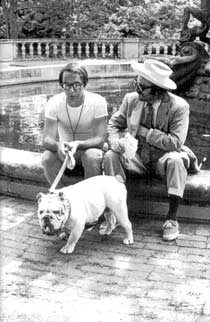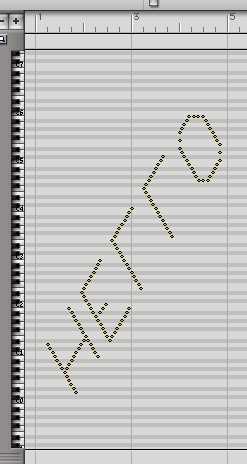If nature is not enthusiastic about explanation, why should Tschaikowsky be?
– Ives, Essays Before a Sonata
I suppose I shouldn’t be so enthusiastic about explanation. It’s a reaction to frustrations of my youth, in which there was so much information I couldn’t get access to: all those years of knowing the names La Monte Young and Charlemagne Palestine, and not being able to hear their music, all those hints of how Le marteau was written in Boulez’s On Music Today, but the final key withheld. Composers like Boulez build up a mystique by keeping their methods secret, and I suppose it’s a smart strategy, but I swore early on I would never do it, even to my own detriment. I may only be flattering myself in so imagining, but there might be a young composer out there curious to figure out how I did what I did in my new piece Solitaire, and I’d rather empower him or her to do something similar than pose as some unapproachable magus.
Solitaire (14:05 in duration) is a piece in which I extremely limited my materials, and vowed not to deviate beyond what happens in the first few measures. My sonic idea was a continuum between perfectly familiar chord progressions and perfectly strange ones. So I started with ii, IV, V, and vi chords in the key of E-flat. (I never use the tonic chord, of course.) I added a major seventh chord on flat III, because it filled out the scale nicely. The other chords are seventh or ninth chords on the 7th, 11th, and 13th harmonics and the 7th subharmonic. For maximum short-circuiting of aural understanding, I mostly go back and forth between the Roman-numeral chords and those based on harmonics, but I occasionally relax into a normal IV-V-vi progression which, I hope, takes the ear as much by surprise as a bizarre outburst would in a more conventional piece. The 29-note scale, for people who can read musical ratios, is as follows:
1/1, 65/64, 33/32, 15/14, 35/32, 10/9, 9/8, 8/7, 6/5, 39/32, 5/4, 9/7, 21/16, 4/3, 11/8, 10/7, 35/24, 3/2, 99/64, 13/8, 5/3, 27/16, 12/7, 7/4, 9/5, 117/64, 15/8, 40/21, 63/32Â
Nine chords gave me 72 possible progressions from one chord to another. I made up a chart of all 72, and, listening over and over, subjectively characterized each one by quality: “weak,” “piquant,” “subtle,” “strongly cadential,” “save for special moments,” and only one “wonderful,” the progression from the 13th to the 11th harmonic (last chord change in the piece). About a fourth of the progressions I prohibited as ineffective. In short, I was merely replicating for this set of chords what hundreds of years have done for the conventional tonal system, learning that IV-ii is much stronger than ii-IV, that IV-I and V-I have different effects, and so on. Then, using those characterizations, I began composing chord progressions into phrases, and still found that whether a chord progression worked or not depended on context and voice-leading, and wasn’t entirely predictable.
The abundant computations I put into making a microtonal scale lead some people to conclude that I compose according to some quasi-serial, left-brain, precompositional scheme, but nothing could be further from the truth. Once I had the chords in place, I had to improvise my way through the piece by trial and error, constantly correcting by ear things that my brain had mistakenly thought might work. I had no idea where the piece was going, except that I was trying to keep it from going anywhere.
To that end I severely limited my materials, giving leeway only to the melodic patterns in the piano, and adjusting the sustained oboe/flute line at a few places where the piano paralleled it too closely. One of my favorite quotations is Kierkegaard’s “Purity of heart is to will one thing.” I wanted, as I often do, to write a piece that was nothing more than one sustained idea. I’m proud of the fact that the piece has no climax, though various parameters hit their extremes at different points; the highest note comes at about six minutes out of 14, and is not an emphasized moment. The piece settles more and more into mid-register as it progresses. I’m even prouder of the fact that, to keep the piece going, I kept coming up with new things I could do that didn’t violate my initial restrictions; the piece’s inventiveness kept moving inward, toward the center. I also like that what form there is is global rather than linear. There is absolutely no logic as to why the piano does this and now that, though overall there are things in the second half that balance things in the first half; the same rhythm or microtonal effect will happen in the treble here and the bass there, or with one pitch here and two pitches there. I aimed for a “vessel of the eternal present,” though certain connections become evident in hindsight.
Clearly, I have a strong affinity for the kind of intense, immobile textural focus one finds in Phill Niblock, John Luther Adams, or Michael Gordon; but if I try to imagine my music as just harmony, rhythm, and texture, and can’t hear the melody in there, the tune, it just doesn’t sound to me recognizably like my music. The impulse that prevents me from retreating behind the objectivity of pure process is the same impulse that prevents me from magisterially keeping my methods secret. I have to have the melodic, the communicative, the human element in there, and it’s not even an ideological decision: I’m not as good at process as those other composers, but I think I have a real talent for the melodic, the personal.
In short, there’s something essentially in-between about me. A passage from the Upanishads reminds me of my composing:
In dark night live those for whom
The world without alone is real; in night
Darker still, for whom the world within
Alone is real. The first leads to a life
Of action, the second to a life of meditation.
But those who combine action with meditation
Cross the sea of death through action
And enter into immortality
Through the practice of meditation.
So we have heard from the wise.
I get my compositional kick by mediating between the objective and the subjective, the public and private, left-brain and right. It’s not enough for me to know secrets of postclassical music, I have to communicate and contextualize them. Similarly, that piano is bringing you (clarifying) the secrets contained in the harmonic structure.
Another conundrum: all my life I’ve been trying to rewrite Harris’s Third Symphony, and I think this is as close as I’ve gotten. If you can hear the connection between that piece and this one (and if it’s impossible I can hardly blame you), my entire life will have just flashed before your eyes. The piece is dedicated to Bob Ashley, for whatever that tells you.




